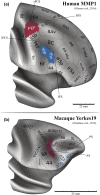Structure, function and connectivity fingerprints of the frontal eye field versus the inferior frontal junction: A comprehensive comparison
- PMID: 34273134
- PMCID: PMC9291791
- DOI: 10.1111/ejn.15393
Structure, function and connectivity fingerprints of the frontal eye field versus the inferior frontal junction: A comprehensive comparison
Abstract
The human prefrontal cortex contains two prominent areas, the frontal eye field and the inferior frontal junction, that are crucially involved in the orchestrating functions of attention, working memory and cognitive control. Motivated by comparative evidence in non-human primates, we review the human neuroimaging literature, suggesting that the functions of these regions can be clearly dissociated. We found remarkable differences in how these regions relate to sensory domains and visual topography, top-down and bottom-up spatial attention, spatial versus non-spatial (i.e., feature- and object-based) attention and working memory and, finally, the multiple-demand system. Functional magnetic resonance imaging (fMRI) studies using multivariate pattern analysis reveal the selectivity of the frontal eye field and inferior frontal junction to spatial and non-spatial information, respectively. The analysis of functional and effective connectivity provides evidence of the modulation of the activity in downstream visual areas from the frontal eye field and inferior frontal junction and sheds light on their reciprocal influences. We therefore suggest that future studies should aim at disentangling more explicitly the role of these regions in the control of spatial and non-spatial selection. We propose that the analysis of the structural and functional connectivity (i.e., the connectivity fingerprints) of the frontal eye field and inferior frontal junction may be used to further characterize their involvement in a spatial ('where') and a non-spatial ('what') network, respectively, highlighting segregated brain networks that allow biasing visual selection and working memory performance to support goal-driven behaviour.
Keywords: brain connectivity; prefrontal cortex; spatial versus non-spatial selection; visual attention; working memory.
© 2021 The Authors. European Journal of Neuroscience published by Federation of European Neuroscience Societies and John Wiley & Sons Ltd.
Conflict of interest statement
The authors report no conflict of interest.
Figures



References
-
- Abdollahi, R. O. , Kolster, H. , Glasser, M. F. , Robinson, E. C. , Coalson, T. S. , Dierker, D. , Jenkinson, M. , Van Essen, D. C. , & Orban, G. A. (2014). Correspondences between retinotopic areas and myelin maps in human visual cortex. NeuroImage, 99, 509–524. 10.1016/j.neuroimage.2014.06.042 - DOI - PMC - PubMed
Publication types
MeSH terms
LinkOut - more resources
Full Text Sources

